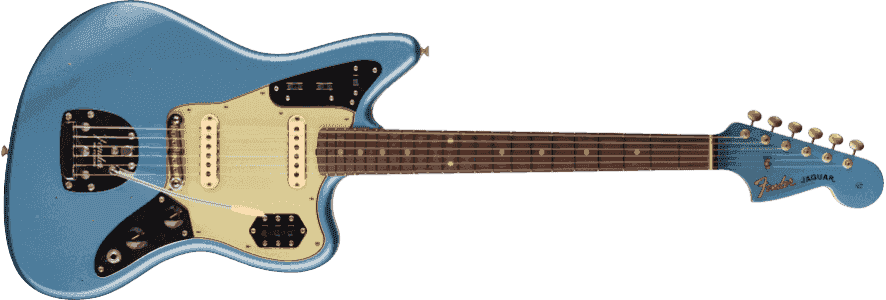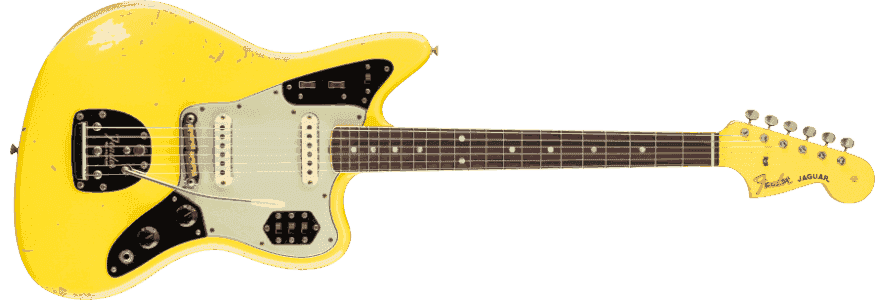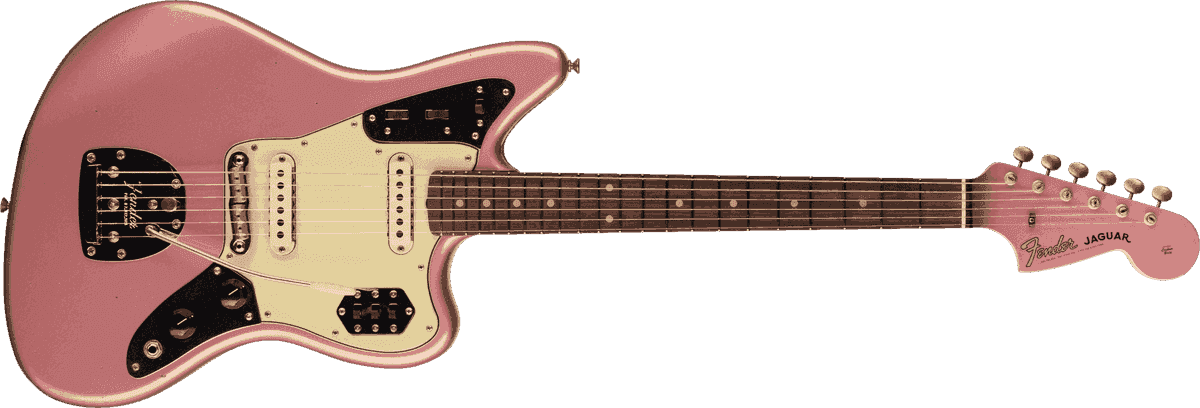Ultimate Fender Jaguar Setup Guide
Master the art of Fender Jaguar setup with our comprehensive guide. Learn how to set up a Jaguar guitar with proper string height, pickup adjustments, and bridge configuration. Whether you're solving Fender Jaguar bridge problems or fine-tuning your jaguar guitar action height, this step-by-step guide covers everything from jaguar string height specs to intonation adjustments. Perfect for both beginners and experienced players looking to optimize their Jaguar's performance.
The Ultimate Fender Jaguar Setup Guide: String Height, Pickup Height & Intonation Tips
The Fender Jaguar, with its distinctive offset body and unique bridge system, offers a tonal palette unlike any other guitar in the Fender lineup. However, its complex setup requirements often intimidate even experienced guitarists. This comprehensive guide will walk you through every aspect of setting up your Fender Jaguar, from basic string height adjustments to solving common bridge problems that plague these iconic instruments.
Whether you're a beginner wondering how to set up a Fender Jaguar or an experienced player looking to fine-tune your jaguar guitar action height, this guide provides the detailed specifications and step-by-step instructions you need to achieve optimal performance.
Part 1: Understanding Jaguar Guitar String Height (Action)
String height, or action, is crucial for both playability and tone on a Fender Jaguar. Due to the Jaguar's unique bridge design and shorter scale length, the ideal string height differs slightly from other Fender models.
Standard Jaguar String Height Specifications (measured at the 12th fret):
- High E string: 1.5 mm (0.059 inches)
- B string: 1.6 mm (0.063 inches)
- G string: 1.7 mm (0.067 inches)
- D string: 1.8 mm (0.071 inches)
- A string: 1.9 mm (0.075 inches)
- Low E string: 2.0 mm (0.079 inches)
These measurements provide a good starting point, but the Jaguar's shorter 24-inch scale length often allows for slightly lower action than Stratocasters or Telecasters. To measure and set your action accurately, consider using a Jim Dunlop String Height Gauge.
Part 2: Adjusting String Height on a Fender Jaguar
The Jaguar's bridge system is one of its most distinctive features, but also one of its most challenging aspects to set up properly. Here's how to adjust your jaguar string height:
-
Understand the Bridge Design: The Jaguar features a floating bridge with individual saddle height adjustments and a separate bridge height adjustment.
-
Adjust Bridge Height First: Use the two bridge height adjustment screws to set the overall bridge height. This affects all strings simultaneously.
-
Fine-tune Individual Saddles: Each saddle has its own height adjustment screw. Use a small Allen wrench such as a D'Addario Multi-Tool to adjust individual string heights.
-
Check for Buzz: Due to the Jaguar's shorter scale length, it's particularly sensitive to fret buzz. Test each string thoroughly after adjustments.
-
Balance with Tremolo: Ensure the bridge height works well with the tremolo system for proper functionality.
The key to successful jaguar guitar action height adjustment is patience and incremental changes. The bridge's floating nature means adjustments can affect multiple aspects of the setup.
Part 3: Fender Jaguar Pickup Height Specifications
The Jaguar's dual single-coil pickups require careful height adjustment to achieve the perfect balance between the neck and bridge positions. The Jaguar's pickups are typically lower-output than Stratocaster pickups, requiring closer positioning to the strings.
Standard Jaguar Pickup Height Settings (measured from the bottom of the string to the top of the pickup pole piece, while pressing the last fret):
- Neck Pickup:
- Bass Side: 2.2 mm (7/64 inches)
- Treble Side: 1.8 mm (5/64 inches)
- Bridge Pickup:
- Bass Side: 2.0 mm (5/64 inches)
- Treble Side: 1.6 mm (1/16 inches)
Adjustment Process:
-
Locate Adjustment Screws: Jaguar pickups typically have height adjustment screws on either side.
-
Start with Bridge Pickup: Adjust the bridge pickup first, as it's more critical for the Jaguar's signature tone.
-
Balance Output Levels: Ensure both pickups have similar output levels when switching between them.
-
Test All Positions: The Jaguar's unique switching system means you need to test all pickup combinations.
-
Fine-tune for Tone: Small adjustments can significantly affect the Jaguar's characteristic "plunky" tone.
Remember that the Jaguar's pickups are designed to work together with its unique switching system, so balance between the two is crucial.
Part 4: Solving Fender Jaguar Bridge Problems
The Jaguar's bridge is often cited as its biggest weakness, but with proper setup, it can be incredibly stable and functional. Here are the most common jaguar bridge problems and their solutions:
Problem 1: Strings Popping Out of Bridge Saddles
Solution:
- Ensure proper string gauge (10-46 or 11-49 work best)
- Check that strings are properly seated in the bridge
- Consider upgrading to a Fender American Professional Jaguar Bridge for enhanced stability
Problem 2: Bridge Rattling
Solution:
- Tighten bridge height adjustment screws
- Apply threadlocker to prevent loosening
- Check that the bridge is properly seated in the thimbles
Problem 3: Intonation Issues
Solution:
- The Jaguar's bridge design makes intonation adjustment challenging
- Use a precision tuner and adjust saddle positions carefully
- Consider the bridge's forward/backward movement in your calculations
Problem 4: Tremolo Not Returning to Pitch
Solution:
- Balance spring tension with string tension
- Lubricate the tremolo mechanism
- Check that the tremolo lock is functioning properly
For additional tremolo balancing concepts that also apply to offsets, see: Stratocaster Tremolo Setup — Float vs Decked.
Part 5: Fender Jaguar Intonation Guide
Intonation on a Jaguar is particularly challenging due to its bridge design. Here's a comprehensive approach to setting intonation:
-
Use a High-Quality Tuner: The Jaguar's intonation is sensitive, so use a precise tuner like the Boss TU-3 Chromatic Tuner.
-
Check Open String Tuning: Ensure all strings are perfectly in tune at the open position.
-
Test 12th Fret Harmonic: Play the 12th fret harmonic and compare it to the 12th fret note.
-
Adjust Saddle Position: Move the saddle forward if the 12th fret note is sharp, backward if flat.
-
Recheck After Each Adjustment: The Jaguar's bridge design means adjustments can affect other strings.
-
Test All Strings: Don't assume that setting one string correctly means others will follow.
Common Intonation Issues on Jaguars:
- Bridge rocking forward/backward during adjustment
- Saddle height affecting intonation
- Tremolo spring tension interfering with saddle position
Part 6: Jaguar Truss Rod Adjustment
The Jaguar's neck requires careful truss rod adjustment due to its shorter scale length and vintage-style construction.
Neck Relief Specifications:
- Target Relief: 0.010-0.012 inches at the 8th fret
- Measurement Method: Capo at 1st fret, press string at last fret, measure at 8th fret
Adjustment Process:
-
Measure Current Relief: Use feeler gauges to check current neck relief.
-
Make Small Adjustments: Turn the truss rod no more than 1/8 turn at a time (use a well‑fitting tool such as the MusicNomad Truss Rod Wrench Set (MN235)).
-
Allow Settling Time: Wait 24 hours between adjustments for the neck to settle.
-
Check in Different Conditions: Temperature and humidity changes affect neck relief.
Vintage vs Modern Considerations:
- Vintage Jaguars may have different truss rod access points
- Modern Jaguars often have easier-to-access truss rod adjustments
- Be extra careful with vintage instruments to avoid damage
Part 7: Best Bridge Setup for Jaguar
The stock Jaguar bridge, while authentic, has limitations. Here are the best bridge setup options:
Stock Bridge Optimization
- Proper Height Setting: Set bridge height so strings clear the bridge plate
- Saddle Adjustment: Ensure saddles are properly aligned and tightened
- String Gauge Selection: Heavier strings (11-49) work better with the stock bridge
- Bridge Plate Lubrication: Apply graphite or specialized lubricant to reduce friction
Aftermarket Bridge Options
Mastery Bridge: The most popular upgrade, offering:
- Enhanced stability and sustain
- Better intonation adjustment
- Reduced string jumping
- Improved tremolo performance
Staytrem Bridge: British-made alternative offering:
- Authentic vintage look
- Improved stability
- Better string retention
- Enhanced tremolo functionality
Mustang Bridge: Budget-friendly option providing:
- Better string retention than stock
- Improved intonation
- Cost-effective upgrade
Part 8: Comprehensive Jaguar Setup Checklist
A complete Jaguar setup involves multiple interconnected adjustments:
Pre-Setup Preparation
- Clean the guitar thoroughly
- Install fresh strings (recommended: Ernie Ball Regular Slinky Nickel Wound Electric Guitar Strings
- Gather necessary tools
- Set up a clean workspace
Neck and Truss Rod
- Check neck relief
- Adjust truss rod if necessary
- Allow neck to settle
- Recheck relief
Bridge and Action
- Set bridge height
- Adjust individual saddle heights
- Check for string buzz
- Test tremolo functionality
Pickups and Electronics
- Set pickup heights
- Test all switching positions
- Check output balance
- Clean potentiometers if needed
Intonation and Tuning
- Set intonation for all strings
- Check tuning stability
- Test tremolo return to pitch
- Fine-tune bridge position
Part 9: Jaguar Maintenance and Care
Proper maintenance ensures your Jaguar performs consistently:
Regular Maintenance Tasks
- String Changes: Change strings every 2-4 weeks depending on playing frequency
- Bridge Cleaning: Clean bridge saddles and threads regularly
- Tremolo Maintenance: Lubricate tremolo mechanism periodically
- Electronics Care: Clean switches and potentiometers with contact cleaner
Environmental Considerations
- Humidity Control: Use a D'Addario Humidipak to maintain proper humidity levels
- Temperature Stability: Avoid extreme temperature changes
- Case Storage: Store in a proper guitar case when not in use
Professional Setup
- Annual Checkup: Have a professional technician check your setup annually
- Major Adjustments: Consult a professional for truss rod or nut work
- Vintage Instruments: Always use a qualified technician for vintage Jaguars
For more information on guitar maintenance, check out our Eco-Friendly Fender Guitar Care Article.
Part 10: Advanced Jaguar Setup Techniques
For experienced players looking to push their Jaguar's performance:
Custom Modifications
- Pickup Upgrades: Consider higher-output pickups for modern applications
- Bridge Upgrades: Mastery or Staytrem bridges for enhanced performance
- Electronics Modifications: Custom switching configurations
- Tremolo Enhancements: Upgraded tremolo arms and mechanisms
Genre-Specific Setups
- Surf Rock: Higher action and bridge pickup focus
- Alternative/Indie: Lower action and balanced pickup settings
- Jazz: Higher action and neck pickup emphasis
- Rock: Medium action and bridge pickup optimization
Recording and Performance Setups
- Studio Setup: Lower action for easier playing
- Live Performance: Higher action for better string control
- Recording Specific: Pickup height optimized for microphone placement
Conclusion
Setting up a Fender Jaguar requires patience and attention to detail, but the results are worth the effort. The Jaguar's unique design and tonal characteristics make it one of the most distinctive guitars in the Fender lineup, and proper setup unlocks its full potential.
Whether you're solving common jaguar bridge problems or fine-tuning your pickup heights, the key is to approach each adjustment methodically and understand how different components interact with each other. The Jaguar's complexity is part of its charm, and mastering its setup is a rewarding experience for any guitarist.
Equip yourself with the right tools and accessories, like the D'Addario Multi-Tool or MusicNomad String Guitar String Cleaner, to ensure your Jaguar stays in perfect playing condition. With proper setup and maintenance, your Fender Jaguar will provide years of exceptional performance and inspire creativity in your playing.
For more setup guides, check out our Stratocaster Setup Guide and Telecaster Setup Guide.
Frequently Asked Questions (FAQ)
1. How do you set the intonation on a Fender Jaguar?
Answer: Setting intonation on a Jaguar requires patience due to its bridge design. Use a precise tuner, check the 12th fret harmonic against the 12th fret note, and adjust saddle positions accordingly. Move saddles forward if the 12th fret note is sharp, backward if flat. Recheck after each adjustment as the bridge design can affect multiple strings.
2. What is the correct string height for a Jaguar?
Answer: The ideal string height for a Jaguar at the 12th fret is 1.5mm for the high E string, gradually increasing to 2.0mm for the low E string. Due to the Jaguar's shorter 24-inch scale length, it can often handle slightly lower action than other Fender models.
3. Why do strings keep popping out of my Jaguar bridge?
Answer: This is a common issue with stock Jaguar bridges. Solutions include using heavier string gauges (11-49), ensuring strings are properly seated, and considering an upgrade to a Fender American Professional Jaguar Bridge or Staytrem Bridge for enhanced stability and string retention.
4. How often should I set up my Fender Jaguar?
Answer: Perform a basic setup every 6-12 months, depending on playing frequency and environmental conditions. Jaguars are particularly sensitive to temperature and humidity changes, so more frequent checks may be necessary in varying climates.
5. What tools do I need for a Jaguar setup?
Answer: Essential tools include Allen wrenches for bridge and saddle adjustments, screwdrivers for pickup height, a string height gauge, feeler gauges for neck relief, a precision tuner for intonation, and a string winder. A D'Addario Multi-Tool covers most basic needs.
6. Can I set up my Jaguar myself, or should I take it to a professional?
Answer: Basic setups can be done at home with proper tools and instructions. However, if you're inexperienced with truss rod adjustments or have a vintage Jaguar, consult a professional to avoid damage. Bridge upgrades and major modifications are best left to qualified technicians.
7. How do I adjust the tremolo on my Jaguar?
Answer: Balance the tremolo spring tension with string tension. Access the tremolo cavity through the backplate, adjust the claw screws to set the bridge angle (floating or decked), and fine-tune spring tension. Test the tremolo's return to pitch after adjustments.
8. What's the best bridge upgrade for a Jaguar?
Answer: The Fender American Professional Jaguar Bridge is the most popular upgrade, offering enhanced stability, better intonation adjustment, and improved tremolo performance. The Staytrem Bridge is a British alternative that maintains vintage aesthetics while improving functionality.
9. How does the Jaguar's shorter scale length affect setup?
Answer: The 24-inch scale length allows for lower action without fret buzz, but requires more precise intonation adjustment. String tension is lower, which can affect tremolo performance and may require heavier string gauges for optimal bridge stability.
10. Why is my Jaguar's bridge rattling?
Answer: Bridge rattling is common on stock Jaguar bridges. Solutions include tightening bridge height adjustment screws, applying threadlocker to prevent loosening, ensuring the bridge is properly seated in the thimbles, and considering an aftermarket bridge upgrade for enhanced stability.
Related Posts
Jaguar-Specific Guides
- Jaguar Truss Rod Adjustment - Detailed neck relief adjustment techniques
- Jaguar Tremolo Setup Guide - Tremolo system configuration
- Jaguar String Gauge Selection Guide - Action height and string gauge selection
Other Fender Guitar Setup Guides
- Telecaster Setup Guide - Complete Telecaster setup process
- Stratocaster Setup Guide - Complete Stratocaster setup process
- Stratocaster Tremolo Setup - Stratocaster tremolo configuration
- Jazzmaster Setup Guide - Jazzmaster-specific setup procedures


